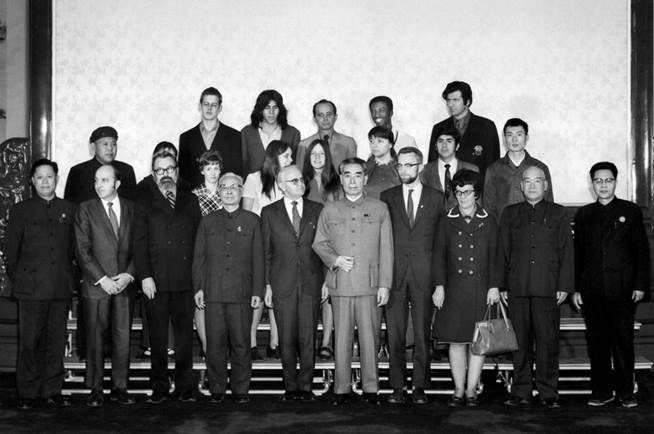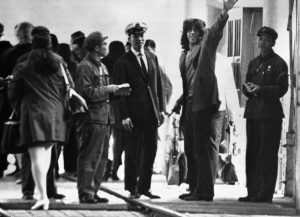It’s the 50-year anniversary of “The Ping Heard Round the World,” a Time Magazine headline in their April 26, 1971 edition. An unexpected invitation for the United States table tennis team to visit China in that year led to Nixon’s visit in 1972, which dramatically changed the course of history. The full story, however, is much more intricate and interesting, and Japan is at the center of it.
Leaders on both sides of the Pacific had been seeking a relationship upgrade since the late 1960s, for entirely practical, realpolitik reasons. President Richard Nixon and his national security advisor, Henry Kissinger, discerned that exacerbating the rivalry between China and the Soviet Union would be a major geostrategic gain. Mao Zedong and fellow Chinese Communist Party (CCP) leaders sought leverage against their erstwhile Soviet ally, and they rather preferred the U.S. Seventh Fleet to stay out of the Taiwan Strait.
Table tennis had long since become a bridge between Japan and China. In 1954, one Japanese player would point a way for China to return to the competitive sports world. Ogimura Ichiro delivered a shocking upset at the 1954 World Championships in London. A Japanese newspaper effused that Ogimura’s 1954 victories (team and men’s singles) came “much to the astonishment of those who still think that Japan’s national sports are cherry-blossom viewing and hara-kiri.” Ogimura led his team to five straight men’s team titles, through 1959.
In “The Origin of Ping Pong Diplomacy,” Itoh Mayumi wrote:
Chinese leaders were inspired… This unexpected and unprecedented victory helped the Japanese to regain their pride after the humiliating defeat in World War II. The Chinese leaders felt that China could also become a world champion in table tennis, since the Chinese and the Japanese had similar body structures.
The CCP committed to investing in China’s table tennis prowess, and discovered a candidate to develop. Rong Guotuan had won Hong Kong’s championship in 1956, and then beaten Ogimura in an informal match, but was omitted from Hong Kong’s roster for the 1957 Asia championships, probably because his family were recent immigrants to the colony from the mainland. China’s offer of financial and other support then became compelling, and Rong “repatriated” in 1957, boasting that he would become the world champion within three years.
It didn’t take that long. Rong won the men’s singles title at the 1959 Worlds in Dortmund, Germany – his first fully international competition. No Chinese had previously won the title. Roger Bennett, author of “Everything You Know is Pong: How Mighty Table Tennis Shaped our World,” said that “Mao declared the triumph the equivalent of a ‘spiritual nuclear weapon’ and Ping-Pong became the prime way China expressed itself to the world.”
Chinese Premier Zhou Enlai invited Ogimura to coach the Chinese players in 1961, an invitation opposed by Ogimura’s teammates and the Japan Table Tennis Association (JTTA), in part because the Japanese saw no reason to strengthen a rival. The Japanese were rightly concerned. The Chinese side edged out Japan in the medal count in 1961, with one of Rong’s top teammates, Zhuang Zedong, winning the men’s singles. China then utterly dominated in 1963 and 1965, with Zhuang winning the men’s gold on both occasions.
But their triumph was short-lived. After Mao launched the Great Proletarian Cultural Revolution in 1966, the zealous in the Party asserted that sports competitions were a bourgeois diversion, that international sports stars were to be not revered, but reviled. Rong and two of his medal-winning teammates were captured by Red Guards, and tortured, and paraded around as examples of revisionists, for more than a year. In summer 1968, following his two compatriots’ examples, Rong threw a rope over a tree branch and hanged himself, a note in his pocket saying “I value my reputation more than my life.” His return to the mainland in 1957 proved a tragic mistake.
Zhuang survived in part by aligning himself with CCP leaders, especially with Mao’s wife, Jiang Qing, a decision that would cost him later. China withdrew from the Worlds in 1967 and 1969, so Japan dominated in those years.
Ping Pong Diplomacy, China-Japan Style
By 1970, Goto Koji, a pioneer of table tennis in Japan who was also head of both the JTTA and the Table Tennis Federation of Asia (TTFA), was convinced that his primary mission was to bring China back to the Worlds, and specifically the 1971 competition, to be held in his hometown, Nagoya. Without China, the Worlds could not live up to their name. Zhuang alone had elsewhere decisively defeated the 1967 and 1969 (Japanese) champions.
Ogimura, by now a close colleague of Goto’s, returned from his 1970 visit to China with the intelligence that Zhou Enlai would consider sending China’s team to the Worlds, provided Goto removed Taiwan from the TTFA. In a December 1970 interview with Japan’s Mainichi Shinbun, Goto declared himself willing to be a “sacrifice” to the greater good of China’s participation in the Worlds, by arranging Taiwan’s expulsion from the TFFA. He therefore became a target of anti-PRC, pro-Taiwan elements in Japan. The police provided a plainclothes bodyguard for Goto, as the fascistic wing in Japanese society had long since robustly demonstrated their commitment to what had come to be called “politics by assassination.”
Goto had only a few weeks to secure China’s participation in the Nagoya Worlds in 1971 – entry applications were due by February 5. Preparing to lead a JTTA delegation to Beijing on January 25, Goto travelled from Nagoya to Tokyo in disguise, reasonably fearing violence. But his mission proved a success – on February 1 the two sides announced an agreement that would bring the Chinese team to Nagoya.
The agreement included the JTTA’s recognition of “three political principles”: no adversarial policies toward China, no conspiracy to create two Chinas (by recognizing both the PRC and the Republic of China government on Taiwan), no obstruction of normalization of China-Japan diplomatic relations. In her book, Itoh writes, “This ‘table tennis formula’ would become a norm for opening other exchanges between China and Japan in various circles, not only in sports but also in culture, economics, and others.” She could have reasonably claimed a broader scope – variations on these principles would become boilerplate for other countries’ normalization of relationships with the PRC, in the 1970s and following.
Goto also succeeded in his willingness to be a sacrifice – he resigned as TTFA president at an urgent meeting called in Singapore in early February 1971, after his motion to remove Taiwan failed a vote.
On the Bus
Premier Zhou had created a multifaceted strategy for leveraging the tournament to resume bilateral exchange with many nations. He instructed the Chinese players to keep their Little Red Books in their pockets, though doing so in China in the Cultural Revolution era was an invitation to violence. On the day after the opening ceremonies, the Chinese delegation invited the teams from Canada, Columbia, and England, among a few others, to visit China after the Nagoya Worlds, which were already the subject of worldwide attention far beyond that usually accorded to the table tennis championships. And that was before U.S. player and hippie icon Glenn Cowan famously boarded the wrong (Chinese) bus after a practice session.
The Chinese players on the bus were quite reasonably reticent. Quoted in The Independent’s obituary in February 2013, Zhuang Zedong said, “The trip on the bus took 15 minutes, and I hesitated for 10 minutes. I grew up with the slogan ‘Down with the American imperialism!’” But in an interview with the Tokyo Shimbun in 2008, Zhuang recalled,
I remembered hearing Prime Minister Zhou Enlai talking about ‘friendship first, match second’. I thought it was my duty to engage. So from the back [of the bus] where I was sitting, I approached [Cowan] and said, ‘I want to express my feelings of friendship’. I gave him an embroidered image of West Lake. [Note: The Japanese article says ‘West Lake’, but the image was actually of China’s Huangshan Mountain.] Cowan replied, ‘You’re the famous Zhuang, right? To receive this from you is great!’
The invitation for the U.S. team to visit China, engineered by Zhou, famously followed. A dozen U.S. table tennis players visited the Great Wall and Summer Palace and played “friendlies” in Beijing and Shanghai. (The Chinese, by far the better players in aggregate, politely left their best games in their locker rooms.) But the state dinner, hosted by Zhou on April 14, was easily the most important diplomatic moment of the trip.
Isabel Hilton opens her 2014 review of Nicholas Griffin’s “Ping Pong Diplomacy” by describing “a photograph, taken in 1971, of one of the most unlikely groups ever assembled in the Great Hall of the People in Beijing. In the back row, Glenn Cowan, a long-haired American college student; at center front stands the late Chinese premier, Zhou Enlai, at his side an elderly bespectacled Englishman. All appear to be looking in different directions, as, indeed, they were.”

In the photo described by Hilton, members of the U.S. table tennis team pose with China’s Premier Zhou Enlai, center foreground, and other Chinese officials in Beijing, China on Wednesday, April 14, 1971. AP Photo.
Hilton’s different metaphorical directions are as resonant today as they were then. But the Chinese side didn’t forget Goto. Premier Zhou referred to him as a “well digger,” referencing the Chinese aphorism, “when you drink water, never forget the source.” Goto died suddenly in January 1972, before he could see the most dramatic outcome of his ping pong diplomacy: Nixon’s visit to China in the spring of that year.
After Mao died, in September of 1976, the Gang of Four were arrested, and Zhuang Zedong found himself on the wrong side of history. He had become even more closely aligned with Jiang Qing in the early 1970s, so he was imprisoned for years, and consigned to internal exile for several more. His first marriage didn’t survive the ordeal, but during the Nagoya Worlds he had met Sasaki Atsuko, a Japanese woman born in 1944 in China to a family that didn’t finally repatriate until 1976. The two eventually married in 1986, but they had to get approval from the highest level of the government to do so, and Sasaki had to abandon her Japanese citizenship. A year later, the couple published a book entitled “Deng Xiaoping Approved our Marriage.”
In a bit of poetic justice, Jiang Qing hanged herself in a hospital bathroom in May 1991, after being released from years of solitary confinement, because she was dying of cancer. By then, Ogimura had extended his zeal for ping pong diplomacy to the Korean peninsula, making dozens of trips there and eventually convincing North and South to play as a unified team at the 1991 Worlds in in Chiba, Japan. Ogimura died in 1994 at the age of 62, also of cancer.
Glenn Cowan died at an even younger age, 52, in 2004, in Los Angeles. He had years before been diagnosed with various psychiatric disorders. Zhuang visited Los Angeles three years later, and met Cowan’s mother, saying his greatest regret was not seeing Glenn again.
So in this cherry blossom season, spare a thought for those lesser-sung heroes, all gone now, who helped pave a way back for China, first to Nagoya, then to normalcy. Ogimura Ichiro, Rong Guotuan, Goto Koji, and Zhuang Zedong – may the echoes of their pings linger a bit longer still.

































